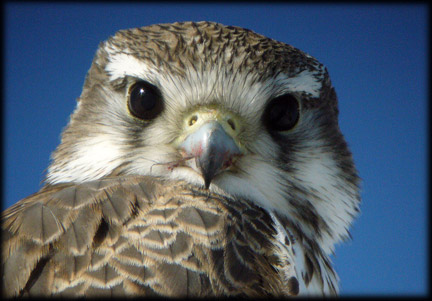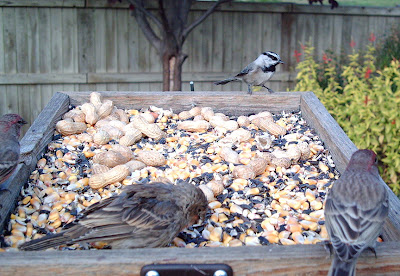 I've had the good fortune to run across several large flocks of Bohemian Waxwings over the last few weeks, but big bunches of birds create a bit of a problem- accurately estimating their numbers. Why count them? Well, for me there are three main reasons.
I've had the good fortune to run across several large flocks of Bohemian Waxwings over the last few weeks, but big bunches of birds create a bit of a problem- accurately estimating their numbers. Why count them? Well, for me there are three main reasons. First, if you are on a Christmas Bird Count, numbers of birds are reported in addition to just the number of species. This yields interesting data- for example, the 707 Bohemian Waxwings found on the Boulder CBC this year is the most since 1987 when 11,000-some were found, and the 5th-most ever out of 66 previous counts.
Second, it provides more useful data if numbers of individual birds are included for other bird monitoring projects rather than just using a species tick- for example, eBird species can be entered as just an "x" for present but giving numbers as well yields more information for the record. Similarly, Breeding Bird Routes and other standardized monitoring protocols call for numbers of birds to be counted.
Finally, it is kind of cool to be able to surmise the size of a flock for the personal satisfaction and discussion value. Sometimes the most notable aspect of a sighting isn't the absolute rareness of a bird in a particular location or time but the number of birds present. While lower than expected numbers can be depressing or worrisome, high counts can be exciting news in most cases (although I don't know what to think of my new yard high-count of 12 Eurasian Collared-Doves today!!)
Still, it is a lot easier to count a few birds than a lot, especially if the lot of them are on the move. Like anything else, it is good to practice, compare estimates with friends (one good trick is to have everyone in your party think of a number without saying it and then to compare guesses.) I've found it instructive to photograph a flock or a part of a flock, guess how many birds are there, and then just buckle down and count them. Typically estimates for large flocks are on the low side, especially with small moving birds (like waxwings!) With that hint in mind, take a look at these Bohemian Waxwings to make a quick estimate of how many are there.
This first flock was found on the Longmont, Colorado CBC, so counting them wasn't just an academic exercise but a real dilemma. The answer will follow so don't scroll down until you are ready, but the point is to estimate them, not actually count them one by one. Click on the frame to enlarge it for a better look at the birds:
 Ok- have your number in mind? Scroll down, then.
Ok- have your number in mind? Scroll down, then. To figure it out for sure, I virtually spray-painted a little dot on each one so I wouldn't miss or double-count any. I used red dots for the first 100 birds and then switched to yellow for the remaining 80, for a total of 180 birds in that segment of the flock. They accounted for about 1/3 to 1/4 of the total flock, so the 500-bird estimate we used in the field wasn't too bad, but probably a bit low. Interestingly, each member of our team initially guessed three very different numbers- 400-ish, 500-ish, and 600-ish. I used the middle number at the time but it probably would have been more accurate to record the high one.

Yesterday, I had the luck of finding another big BOWA flock. I had gone out back to fill the bird bath in the morning, and heard Bohemians somewhere to the north. Grabbing my camera, I headed out into the neighborhood to see what I could find. A few blocks away I came across a memorable scene- a house with BOWAs draping three crabapple trees, BOWAs burdening bare cottonwoods waiting for their turn, BOWAs flying to the ground to eat snow, and BOWAs speckling the roof for even more snow consumption. In other words, a Bohemian brouhaha was in progress. I'll admit that at first I was more interested in photographing individuals and small groups- some little voice in the back of my mind kept asking how many birds were around but the bigger voice said "LOOK AT THAT ONE- GET A PICTURE WHILE IT IS UNOBSCURED BY BRANCHES AND IN THE GOOD LIGHT!!!" Before long, however, a diesel pickup chugged by, scaring all of them into the air. They milled around a bit and then formed a long river of birds heading off to their next destination. At that point I had a number in mind, but more on that later. Here's a shot I got of part of the flock, mostly in flight but with a few perched. If you are still with me after all of this, and still want to play, take another guess. Answer to follow, so scroll down when you are ready...
 Got a guess? OK then...
Got a guess? OK then... Again, I used a different color dot for each 100 birds, using 7 colors but only 98 orange dots. Thus I count 698 birds in this frame, which I thought was about 1/3 of the total. I had guessed about 2000 birds so I wasn't too far off, but not surprisingly I was still low on my estimate.
Again, I used a different color dot for each 100 birds, using 7 colors but only 98 orange dots. Thus I count 698 birds in this frame, which I thought was about 1/3 of the total. I had guessed about 2000 birds so I wasn't too far off, but not surprisingly I was still low on my estimate. So keep practicing your counting of bird flocks. For some really helpful tips and methods, check out these two articles put together by the eBird staff:
Bird Counting 101
Bird Counting 201
And for some virtual bird counting practice try this:
Bird Counting Game
























































